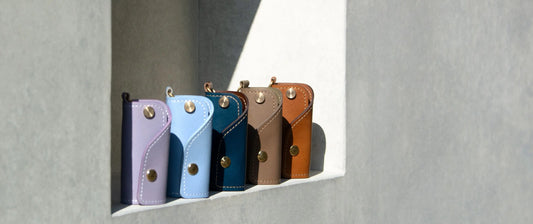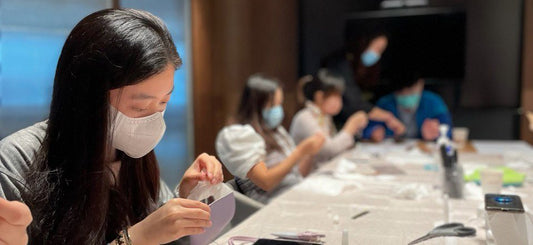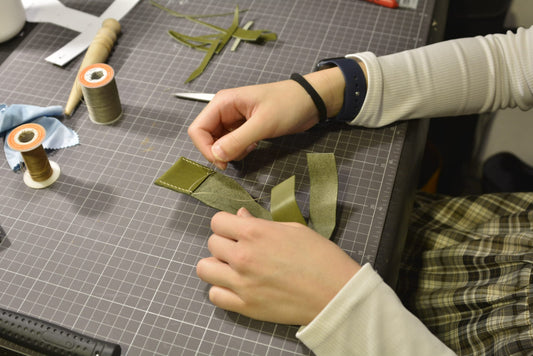
What is Leather? Don’t be Intimidated by Professional Terms Anymore
Share
“Genuine, animal hide, top grain, split leather, alligator pattern, blah blah blah…” Have you ever been overwhelmed by the above professional terms while trying to buy a piece of leather goods? Leather has been a darling of the fashion world for years, with leather goods such as handbags, leather jackets, leather skirts etc. Occupying a prominent place in major fashion shows and films. In our daily lives, small items like wallets, card holder, belts and more are often made of leather, closely intertwined with our lives. Before purchasing finished leather goods, let’s understand the raw materials, advantages, and production methods of leather pieces.
Materials for Leather
Leather is sourced from animal hides and fur. Approximately 90% of the world’s leather supply comes from cowhide, which is a byproduct of cattle raised for meat. Other common sources included goatskin, pigskin, as well as exotic leathers like deer, kangaroo, alligator, ostrich, python, and more. The terms “top grain” and “split” mentioned at the beginning refer to the layers of that piece of leather from the original animal hide.
Layers of Leather
Top Grain Leather
The uppermost layer of the hide, just below the hair. It is considered one of the highest quality types of leather.
- Smooth Texture : Top grain leather has a smooth surface due to the removal of the outer layer (full grain).
- Natural Markings : It retains the natural grain and marking of the animal hide, making each piece unique.
- Durability : It is durable and ages well, developing a patina over time.
- Breathability : Top grain leather is breathable due to its natural pores.
Split Leather
The lower layers of the hide after the top grain had been removed. It is also known as suede or corrected-rain leather.
- Less Durable : It is not as strong or durable as top grain leather due to the removal of the top grain layer.
- Affordability : Split leather is more affordable compared to top grain leather.
- Usage : Often used in products where the appearance of suede is desirable, such as jackets and some furniture.
Advantages of Leather
Elegance and sophistication
The texture of genuine leather goods is unmatched by other fabrics or synthetic leathers. Each piece of leather carries unique natural patterns, and it doesn’t develop permanent wrinkles when pressed. On a genuine vegetable-tanned leather, it’s color will slowly change darker by the time it was used and exposed under sunlight. Unique marks will also be made by your own sweat and oil. While some faux leather items try to mimic its apperance through dyeing methods, the results often fall short in comparison.
High breathability
The significant difference between genuine leather and synthetic leather is the presence of tiny pores on animal hidesm allowing products made from genuine leather to be breathable. This subtle breathability is crucial, especially in leather footwear. The breathability provided by genuine leather shoes is something that plastic or faux leather shoes can’t match. Many plastic or faux leather boots on the market lack proper breathability, leading to foot perspiration, fungal growth, and issues like athlete’s foot, nail fungus, and foot odor. Genuine leather shoes are less likely to cause these problems.
High tensile strength
When compare to soft materials like cotton, linen, nylon, PVC leather, etc., genuine leather cowhide ranks among the top in terms of tensile strength at the same thickness. Before the apperance of synthetic industrial belts, leather belts were commonly used in machinery for industrial transmission. Despite technological advancements leading to alternatives in industrial applications, many everyday items are still better off with natural leather. For instance, a high-quality leather belt has much hiher tensile strength than a rubber belt, reducing the chances of deformation and damage after pulling, makin the leather item a more durable and effective choice.
From Hide to Leather : The Production of Leather Material
As mentioned above, animal hide leather is a byproduct of meat industry. There are a few processes to make an hide to a piece of completed leather.
Rawhide production
After the hides of cattle from meat production are processed to remove hair, fat, and flesh. They are air-dried to become rawhide, which can be storaged for a long time.
Tanning
At the tannery, rawhide undergoes tanning process such as socking in water and alkaline solutions to turn it into “leather”. Depending on whether plant tannins or chemicals (often chromium) are used in the tanning process, the resulting leather will be vegetable-tanned leather or chrome-tanner leather.
Coloring & Coating
Finally, the tannery colors the processed leather by spraying or dyeing. The choice of coloring method results in different finished effects. Some leather products receive special coating treatments that can turn them into multifunctional leather products like eater-repellent leather available in the market.




